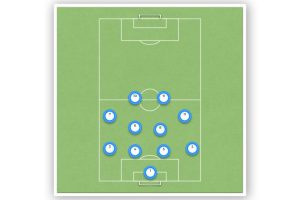The Best Formations for a Low Block Defense in Soccer: Expert Tips and Strategies
If you are looking to build a solid defense in soccer, you need to choose the right formation that suits your team’s style of play. One of the most effective tactics for defending is the low block. It is a strategy that involves positioning your players deep in your own half, aiming to limit the space in behind for the opposition to exploit.
When it comes to choosing the best formations for a low block defense in soccer, there are several options that you can consider. One of the most popular formations for a low block defense is 4-4-2. This formation is known for its defensive solidity and has been used by many successful teams over the years. Another option is the 5-3-2 formation, which is perfect for teams that want to absorb pressure for long periods and counterattack.
Ultimately, the choice of formation will depend on your team’s strengths and weaknesses, as well as the opposition’s style of play. In this article, I will explore the best formations for a low block defense in soccer, their advantages and disadvantages, and how to implement them effectively. Whether you are a coach or a player, this guide will help you build a solid defense that can withstand even the toughest of attacks.
The Importance of a Low Block Defense
As a coach, I believe that a low block defense is one of the most important strategies for a team to master. It is a defensive tactic that involves positioning your team deep in your own half of the field, with the aim of denying the opposition space to attack and limiting their scoring opportunities.
One of the key advantages of a low block defense is that it allows teams to defend as a unit, making it difficult for the opposition to penetrate through the middle of the field. This is achieved by having a compact defensive shape, with the midfielders and defenders dropping deep and narrowing the space between them.
Another advantage of a low block defense is that it can be used to great effect against teams that rely heavily on possession-based football. By staying compact and organized, teams can frustrate their opponents and force them into making mistakes, which can then be exploited on the counter-attack.
However, it is important to note that a low block defense can also have its drawbacks. One of the main challenges is that it requires a high level of discipline and concentration from the players, as they must be able to maintain their shape and avoid getting pulled out of position. Additionally, a low block defense can be vulnerable to teams that are able to move the ball quickly and create space in behind the defense.
To summarize, a low block defense is a highly effective strategy for teams looking to defend deep and limit the opposition’s scoring opportunities. While it requires a high level of discipline and concentration from the players, it can be used to great effect against possession-based teams and can be a valuable asset in a team’s defensive arsenal.
Formations for a Low Block Defense
When it comes to defending in soccer, a low block defense is a popular strategy that many teams use. This strategy focuses on protecting the defensive third of the pitch by remaining compact in a deep position, defending the space close to goal.
4-4-2 Formation
The 4-4-2 formation is a classic formation that can be used as a low block defense. In this formation, there are four defenders, four midfielders, and two forwards. The midfielders are split into two central midfielders and two wide midfielders. The two forwards play up front and are responsible for pressuring the opposition’s defense.
The 4-4-2 formation is a great formation for a low block defense because it allows for a solid defensive structure. The four defenders can stay compact and limit the space in behind for the opposition to exploit. The two central midfielders can also drop back and help defend when necessary.
5-3-2 Formation
The 5-3-2 formation is another formation that can be used for a low block defense. In this formation, there are five defenders, three midfielders, and two forwards. The five defenders are split into three central defenders and two wing-backs. The three midfielders are split into one central midfielder and two wide midfielders. The two forwards play up front and are responsible for pressuring the opposition’s defense.
The 5-3-2 formation is a great formation for a low block defense because it allows for a solid defensive structure with an extra defender. The three central defenders can stay compact and limit the space in behind for the opposition to exploit. The wing-backs can also drop back and help defend when necessary.
3-5-2 Formation
The 3-5-2 formation is a more attacking formation that can also be used for a low block defense. In this formation, there are three defenders, five midfielders, and two forwards. The three defenders are split into one central defender and two wing-backs. The five midfielders are split into three central midfielders and two wide midfielders. The two forwards play up front and are responsible for pressuring the opposition’s defense.
The 3-5-2 formation is a great formation for a low block defense because it allows for a solid defensive structure with an extra midfielder. The three central midfielders can drop back and help defend when necessary. The wing-backs can also drop back and help defend when necessary.
| Formation | Pros | Cons |
|---|---|---|
| 4-4-2 | Solid defensive structure | Can be too defensive if not used correctly |
| 5-3-2 | Extra defender for added defensive stability | Less attacking options |
| 3-5-2 | Extra midfielder for added defensive stability | Less defensive stability with only three defenders |
Tactics for a Low Block Defense
Defending Deep
When playing a low block defense, the priority is to remain compact in a deep position, defending the space close to goal. The back line should be positioned deep, aiming to limit the space in behind for the opposition to exploit. In this formation, the midfielders must drop back and help defend the space in front of the backline. One effective way to defend deep is to use zonal marking. This means that each player is responsible for a specific zone of the field, rather than marking an individual player. This can help prevent gaps from opening up in the defense, as players can shift and cover each other’s zones.
Counter-Attacking
When playing a low block defense, counter-attacking can be an effective way to score goals. This involves quickly transitioning from defense to attack, catching the opposition off guard. Players must be quick and decisive, making the most of any opportunities that arise. To counter-attack effectively, the team must have pacey players who can quickly move the ball up the field. The midfielders must be able to quickly transition from defense to attack, and the forwards must be able to make runs into space behind the opposition defense.
Pressing
Pressing can be an effective way to disrupt the opposition’s attack and win back possession. When playing a low block defense, pressing must be done strategically, as players cannot afford to be caught out of position. One effective way to press is to focus on specific areas of the field. For example, the team could focus on pressing the opposition’s midfielders when they receive the ball in certain areas. This can help prevent the opposition from building up play and force them to play long balls, which can be easier to defend against. Overall, when playing a low block defense, the team must remain organized and disciplined. Each player must know their role and be able to quickly transition between defense and attack. By defending deep, counter-attacking, and pressing strategically, the team can effectively defend against the opposition’s attack and create scoring opportunities.
Training for a Low Block Defense
Positioning and Movement
When training for a low block defense, it is important to focus on correct positioning and movement. Players need to be able to maintain a compact shape and limit the space for the opposition to exploit. This means that defenders should be positioned deep and narrow, with the back line playing close to the goal.
Players should also be able to move quickly and efficiently in order to close down space and block shots. This requires good communication and coordination between defenders, as well as a solid understanding of each other’s roles and responsibilities.
| Key Points | Training Exercises |
|---|---|
| Compact shape | Small-sided games with limited space |
| Positioning | Defensive drills with a focus on deep and narrow positioning |
| Movement | Reaction drills with quick changes of direction and pace |
Communication and Coordination
Effective communication and coordination are essential for a successful low block defense. Players need to be able to work together to close down space and block shots, while also being aware of their own responsibilities and roles within the team.
Training exercises should focus on improving communication and coordination between players, with a particular emphasis on clear and concise communication. This might include drills that require players to communicate with each other while under pressure, or exercises that focus on improving awareness and decision-making.
| Key Points | Training Exercises |
|---|---|
| Clear communication | Drills that require players to communicate under pressure |
| Awareness and decision-making | Exercises that focus on improving player awareness and decision-making |
Set Pieces and Dead Ball Situations
Set pieces and dead ball situations can be particularly dangerous for a low block defense. It is important to train players to be aware of the potential dangers and to be able to defend against them effectively.
Training exercises might include drills that focus on defending against free kicks, corners, and other set pieces, as well as exercises that simulate game situations and require players to make quick decisions under pressure.
| Key Points | Training Exercises |
|---|---|
| Defending set pieces | Drills that focus on defending against free kicks, corners, and other set pieces |
| Game situations | Exercises that simulate game situations and require players to make quick decisions under pressure |
Conclusion
In conclusion, I have discussed the best formations for a low block defense in soccer. The 4-4-2 and 5-3-2 formations are the most common and effective formations for a low block defense. These formations provide a solid defense in the central areas of the pitch and make it difficult for the opposition to penetrate. The 4-4-2 formation is a classic formation that provides a solid defense with four defenders and four midfielders. The two strikers up front can also provide a threat on the counter-attack. The 5-3-2 formation is another option, which provides an extra defender and a more compact defense in the central areas of the pitch. It is important to note that the success of a low block defense is not just about the formation. It also requires a well-organized and disciplined team that is willing to work hard and defend as a unit. Communication and teamwork are key to the success of a low block defense. Overall, the best formation for a low block defense is the one that suits your team’s strengths and style of play. The 4-4-2 and 5-3-2 formations are great starting points, but it is important to experiment with different formations and tactics to find what works best for your team. With hard work and dedication, any team can successfully implement a low block defense and frustrate their opponents.







